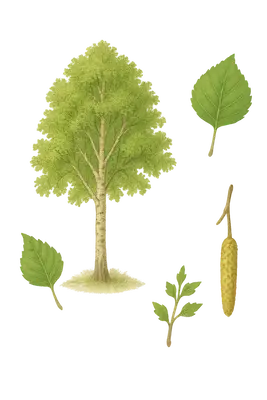Tree Pollen
Description
Trees are vital components of ecosystems worldwide, providing oxygen, improving air quality, and offering habitat for wildlife. However, many tree species release pollen during their reproductive cycles, which can be a significant allergen for individuals susceptible to hay fever (allergic rhinitis). Common allergenic trees include oak, birch, cedar, maple, and pine.

Allergy Symptoms
Exposure to tree pollen can trigger various allergic reactions, including:
- Nasal symptoms: Sneezing, runny or congested nose.
- Ocular symptoms: Itchy, watery, and red eyes.
- Respiratory issues: Coughing, wheezing, and exacerbation of asthma symptoms.
- Skin reactions: Itchy skin or hives in some individuals.
In certain cases, individuals may experience Oral Allergy Syndrome (OAS), characterized by itching or swelling of the mouth and throat after consuming certain fruits or nuts that cross-react with tree pollen.
Typical Pollination Period
The pollination period for trees varies by species and geographic location:
- United Kingdom: Tree pollen season typically occurs from February to June, with variations depending on the specific tree species.
- United States: Many trees release pollen in the spring, starting as early as February and extending into May in some regions.
- Europe: In central and northern Europe, early pollinating trees such as hazel and alder can release pollen from December to April, extending the period of allergy symptoms for many patients.
Geographic Distribution
Allergenic trees are found worldwide, with distribution depending on the species:
- Urban areas: Many cities have a mix of native and ornamental trees that can contribute to pollen levels.
- Rural areas: Forests and woodlands with high densities of trees can lead to significant pollen exposure during pollination periods.
- Coastal regions: Areas near the seashore may experience lower pollen levels due to offshore winds preventing pollen from inland trees from reaching the coast.
Tips for Reducing Exposure and Managing Allergies
- Monitor pollen forecasts: Stay informed about local tree pollen levels during the pollination season.
- Limit outdoor activities: Especially on high pollen count days and during early morning hours when pollen levels are typically higher.
- Protect indoor environments: Keep windows closed and use air purifiers to reduce indoor pollen exposure.
- Personal hygiene: Shower and change clothes after being outdoors to remove pollen.
- Medication: Use antihistamines, nasal corticosteroids, or other allergy medications as recommended by a healthcare professional.
- Consult an allergist: For persistent or severe symptoms, seek advice from an allergist who may recommend immunotherapy or other treatments.